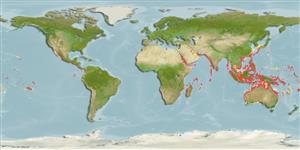>
Eupercaria/misc (Various families in series Eupercaria) >
Labridae (Wrasses) > Corinae
Etymology: Halichoeres: Greek, als, alis = salt + Greek, choiros = pig (Ref. 45335).
More on author: Bennett.
Environment: milieu / climate zone / depth range / distribution range
Ecología
marino asociado a arrecife; rango de profundidad 10 - 40 m (Ref. 90102). Tropical
Indo-West Pacific: Persian Gulf (Ref.80050); Red Sea and the Gulf to Samoa, north to southern Japan, south to the Great Barrier Reef (Ref. 9710). Western Indian Ocean: Mozambique (Ref. 41878).
Tamaño / Peso / Age
Maturity: Lm ? range ? - ? cm
Max length : 20.0 cm TL macho / no sexado; (Ref. 9710)
Espinas dorsales (total): 9; Radios blandos dorsales (total): 11; Espinas anales 3; Radios blandos anales: 11. Females light bluish gray dorsally, white ventrally, with a narrow orange stripe running from the top of the snout to the upper base of the caudal fin (where it may contain a blackish spot). Males blue-green on head and anterior portions of the body with irregular pink band and spots; their orange-yellow lateral stripe blue-edged, often with narrow extensions; a blue-edged spot at the upper portion of the pectoral fin base, and two or more similar blue-edged spots just anterior of the caudal peduncle above the lateral stripe.
Inhabits open sand and rubble areas of seaward reefs, to depths greater than 34 m (Ref. 9710). Usually in small groups of females with single males patrolling the area (Ref. 48636).
Life cycle and mating behavior
Madurez | Reproducción | Puesta | Huevos | Fecundidad | Larva
Distinct pairing during breeding (Ref. 205).
Randall, J.E., G.R. Allen and R.C. Steene, 1990. Fishes of the Great Barrier Reef and Coral Sea. University of Hawaii Press, Honolulu, Hawaii. 506 p. (Ref. 2334)
IUCN Red List Status (Ref. 130435)
Warning: mysqli::__construct(): (HY000/1040): Too many connections in /var/www/html/includes/func_getlabel.php on line 46
Can't connect to MySQL database (fbapp). Errorcode: Too many connections
